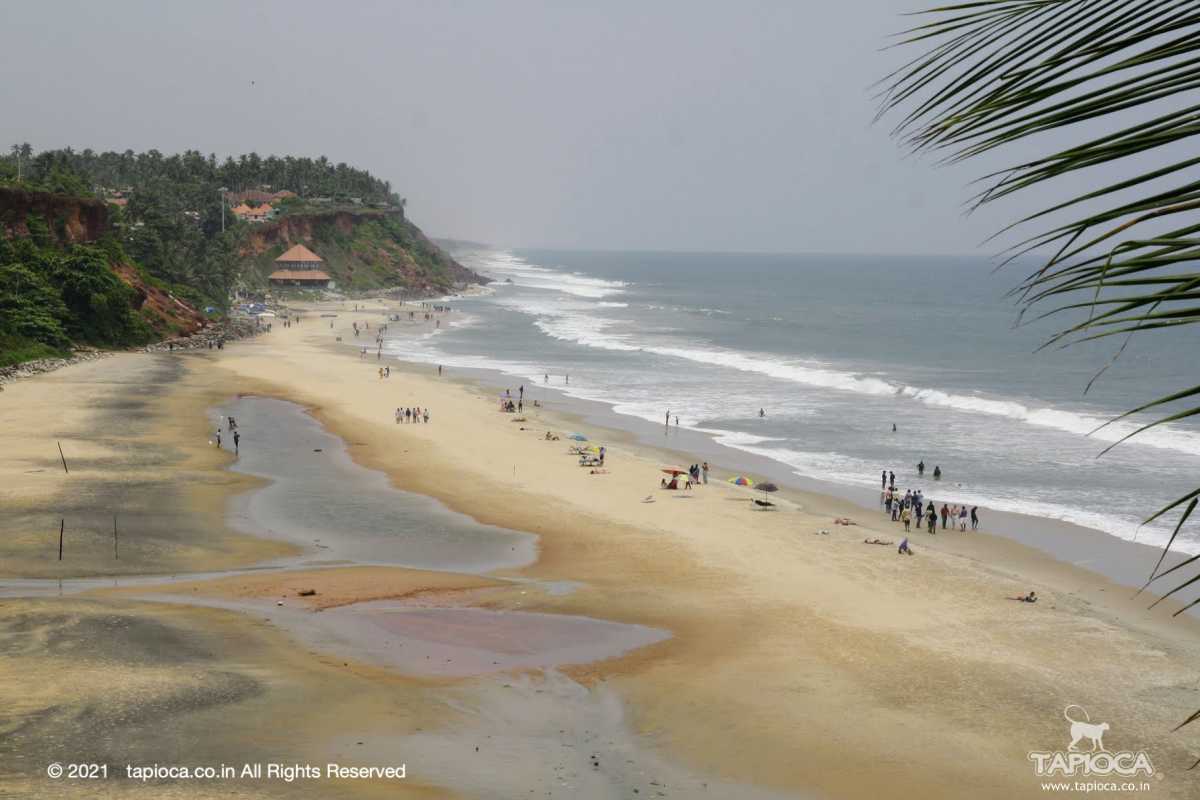Attractions in Varkala
From a tourism perspective, the beaches of Varkala stand first.

Varkala
Varkala Beach & Fresh water spring joining the sea
T
here are many uniqueness to these beaches. First of all it is a recently ‘discovered’ tourist destination. Means, for quite sometime Varkala was in those lists of places secretly shared by seasoned backpackers.Varkala appeared But things have changed. Now Varkala has a tourism identity of its own. But still Varkala retains its charm as a recently discovered destination.
The beaches are wide and arch shaped. Overlooking the beach is the steep cliffs with coconut palm groves all over it. During high tide the waves almost laps at the base of these cliffs.
While the beach is sandy , the cliffs next to it is of reddish laterite. Geologists call these unique looking laterite hills as Varkala Formation. Most of the beach accommodations are located on these areas .
A freshwater spring – believed to be off medicinal qualities – crosses the beach before flows into the sea. One can spot many water sprouts on the hills , especially post monsoon period.
One can also spot some rocky outcrops on the beach as the water recedes.
This beach has some serious religious significance too for the Hindus. People come over here to do the last rites after the funeral of the immediate relatives. Thus the sea coast over here has earned the name Papanasam , literally means the destroyer of sins.
This area of the beach is considered sacred ( where the main road from the Janardhana Swamy Temple ends at the beachfront ) . The tourist part of the beach is a few minutes walk towards north along the coastline, after crossing the medicinal spring.
One can see the whole paraphernalia typical of a tourist beach side, including the sign posts that warns one not to venture into sea when there are no lifeguards around.
While there are many roads that lead to Varkala beach , the one near the Janardhana Swamy Temple and the road leading to the Helipad area are the main access points to the beach.
Janardhana Swamy Temple is one of the oldest temples in India. The temple enshrines the idol of Lord Vishhu. The temple is at an elevation. A flight of steps lead to the compound. The sanctorum is inside a cloistered outer structure.
Ancillary shrines are located outside the main temple at its corners. The most interesting is the open shrine for the snake gods , located axial to the sanctorum. There are many idols of snake gods placed around the banyan tree. The twisting roots of the tree has practically engulfed many of these snake idols. That speaks of the antiquity. Quite a large part of the temple appears modern. But in general , especially the inside still retains the oldness.
The large temple pond with a zillion tiny fishes is located , just across the road. In fact the road to beach pass between the temple and the pond.Cannon ball tree (Couroupita guianensis) athe Janarthana Temple in Varkala
The temple and the pond is treated with reverence by the Hindus. Though Janardhana Swamy Temple is close to a beach community , this is no tourist monument. A board installed inside the temple compound says the admission inside the temple is restricted to followers of Hinduism. However there would not be any problem in seeing it from outside even if you are non Hindu. Dress modestly and observe the local customs ( no footwear inside etc ) . Ask people at the temple premise how close you can go just to see the temple. You would not offend anyone for seeking the clarification.
Photography prohibited in the sanctum area. However you can shoot within the temple courtyard after paying camera use fee.
The mausoleum of the social reformer guru atop the Sivariri Hills is a popular attraction. It's a 10 minutes taxi/bus ride from Varkala town center. There is road winding all the way up to the hilltop where the mausoleum is located. Or you can trek, along the stepped trail through a semi forested hillside.
If one think that Varkala is in the an off the beaten path , imagine the off the beaten paths of Varkala!
Anjengo or Anjuthengu meaning ‘Five Coconut Trees’ in the local parlance. The three century old Portugese built fort that was later captured the Dutch and later by the then English East India Company and the cemetery inside is an interesting attraction. Other than this bastion Anjengo is a serene village blessed with a majestic lake and sandy beach ( a secret beach !).
Check out the lakes ( backwater lakes) at Nadayara and Kozhithottam near to Varkala. Kappil beach south of Varkala is unique, as you can enjoy both the beach and backwaters in one shot!
One can make a short side trip to Manthara from Varkala . Take a view from the cliff or visit the local Krishna Temple. Of course there is the Thiruvambadi beach right down the cliff.
Parippally , the small town about 10 kilometers from Varkala , on the NH 47 is popular for the annual elephant procession. Many dozen elephants are brought for this festival from different parts of Kerala.
